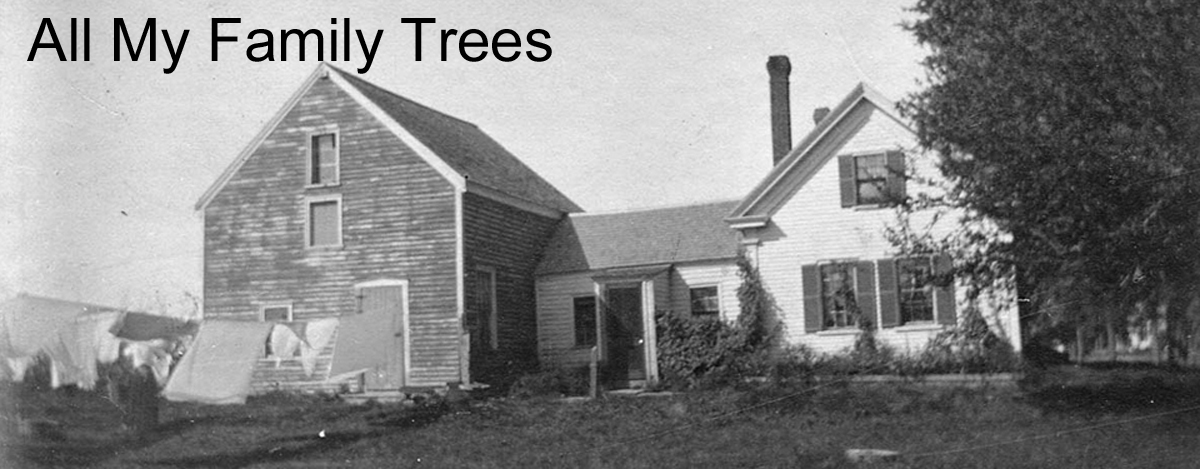Today was the monthly meeting of the Pima County Genealogy Society. Although I live in Arizona, the only relatives I have that were born here are my children. Every one of my ancestors lived and died in the Midwest or New England states. So, why do I care about the local genealogy society, you might ask? Well...I'll tell you.
First, a little background. If you have been following my blog, you know that I uploaded a photo that I believed was taken in Kennebunk, Maine about 1900 in my post "Wordless Wednesday - Julianna Marie (Rasmusdatter, Christenson) Bye". A reader asked me if the building in the background was still standing, and I have been trying to find out ever since (see "Those Places Thursday - Is That Building Still Standing?") with no success. Today's PCGS program included a presentation on Google search tips. One of the many things I learned at that meeting was that you can upload a photo from your PC to Google images and search for similar images. If you are lucky, you just might find other photos of that object or place that will identify what and where it is. You can guess that I rushed right home and uploaded that image.
First, I uploaded the entire photo. The Google image search found that exact photo on my blog, and then gave me some interesting "visually similar images". One of those led me to an image at the New Jersey Historical Society website of two men with bicycles standing in front of a house that had been lifted off its foundation by a tornado in 1895 and dropped back down on its cellar. The house toppled over because it wasn't aligned properly. Go take a look at it...it's really interesting.
 | |
| Results of uploading the full photo into Google images. |
 |
| Results of uploading just the building into Google images. |
The other presentation at today's meeting was on newspapers. I have been relatively successful in finding newspaper articles on my family by using GenealogyBank.com or NewspaperArchive.com. However, I have scanned copies of two newspaper articles that I have not been able to locate the newspaper in which they appeared (the original articles were cut out of the newspaper and the source was not cited). One is an article about my grandfather being arrested for bootlegging; the only clue I have is that his age stated in the article dates it between November 1942 and November 1943 and they gave the location of the still (in his home in Skokie, Illinois). The other article is about my uncle that was shot down over France in WW II and listed as MIA. The article published a letter of commendation sent to my grandparents by his commanding officer; the only clues I have is that I know he was shot down in June 1943 and my grandparents did not receive notice that he was alive until November 1943, and it mentioned that my grandparents lived in St. Augustine, Illinois.
I used some of the techniques that were taught at our meeting. We learned to Google "town name" newspaper (e.g. "Skokie" newspaper) to find websites for the newspapers servicing that town. Going to the newspaper websites gives you directions on how to find old articles in their archives. This usually involves contacting someone at the newspaper via email or regular mail.
I also searched the US Newspaper Directory, 1690-Present on the Library of Congress' Chronicling America website to find the names of newspapers that were operating in those cities in the 1940s and to find the libraries that hold microfilm copies of those newspapers. My next step will be to try an inter-library loan of the microfilms. This is way more tedious than finding the articles online with a search engine, but as we all know not everything is online. Sometimes you just have to do things the old school way.
There are many, many more tips we learned for using the Google search engine and for finding newspapers which I would have never found if I had not attended my local genealogy society's meeting today. If you are fortunate enough to have a genealogy society operating in your town, I highly recommend you look into the benefits they offer to their members. If you don't know what societies are close to you, try looking on the Genealogy Society Directory or Cyndi's List Societies & Groups.
Thanks for dropping by.
Society Saturday is a daily blogging prompt from GeneaBloggers.


















